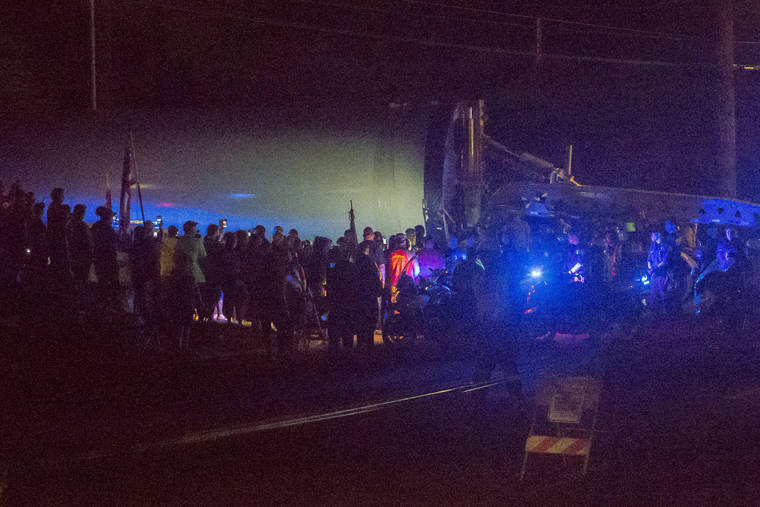HONOLULU — More than 30 people accused of disobeying a police officer in the Na Pua Makani wind farm protest made their initial appearance in court Monday on the same day 18 additional people were arrested for attempting to block yet another convoy of turbine parts.
Disobeying a police officer is considered a petty misdemeanor that carries penalties of up to 30 days in jail, a $1,000 fine and up to a year of probation.
But many of the protesters who appeared before Judge Sherri Iha at Waianae District Court in the Kapolei Court Complex accepted a deal to plead no contest to a lesser obstruction violation.
The judge imposed a $100 fine on each of them, with higher fines slapped on a few who were arrested more than once.
Although a majority of the 21 protesters represented by attorney Aaron Wills accepted the deal, a few of them pleaded not guilty to disobeying a police officer. Their trial date has been set for January.
Wills said the arrests continue because folks want their voices to be heard.
“The state has failed multiple times as a trustee of these lands to protect the environment and hold the permittees accountable,” he said.
Another attorney, Melvin Masuda, represented several other protesters who appeared in court Monday, and at least six protesters represented themselves.
Early Monday morning, 18 people were arrested in Kalaeloa in yet another attempt to block vehicles from transporting wind turbine parts from Kalaeloa to the project site in Kahuku. All were released after posting bail, police said.
Following the pushing-and-shoving clash between protesters and police early Friday morning, AES Corp. installed plastic barricades topped by chain-link fencing at the storage yard driveway.
But the protesters responded by using PVC tubes, chains and duct tape to interlock people lying in the driveway. Four protesters linked themselves in pairs through holes in the water-filled barricades using what some called “PVC lockboxes,” tactical protest tools that make it difficult for police to free the protesters from each other but easy for them to release themselves.
The move almost worked. It took officers using various power tools and saws four hours Monday night into Sunday morning to clear the driveway before allowing the convoy to commence its 40-mile trip to the North Shore at about 3:10 a.m.
Arrests began just past 11 p.m. Sunday, but it wasn’t until after 3 a.m. that the first pair of lockbox protesters was finally cut free. It took over 90 minutes to cut two women locked to the barricade, as the crowd yelled at police, “Call it off.”
In the end, officers had to leave one protester on the edge of the driveway, and they surrounded her as the trucks roared by.
“The vehicles were allowed onto the road after it was determined that they could be safely driven past the protester,” police spokeswoman Michelle Yu said.
Meanwhile, protesters were upset that police ignored their requests to give the locked protesters safety equipment to shield the women from the smoke and sparks that flew from the power tools being used to cut them loose.
Protest leader Nakia Naeole implored police over a megaphone to have the Emergency Medical Services team on the scene to give the locked women attention.
“They were coughing, complaining about sparks touching their body, their face, ” Naeole said. “So we had to offer them blankets. We found respirators for them — not HPD.”
Naeole later represented himself at his Kapolei arraignment. He pleaded no contest to an obstruction violation and paid a $100 fine in connection with an Oct. 20 arrest where he and other protesters attempted to prevent trucks carrying turbine parts from leaving Kalaeloa.
Naeole said they remain steadfast in their opposition against the wind turbines. “This is our fight against greed energy … G-R-E-E-D, ” he said after his arraignment. “This is greed energy at its finest.”
According to AES Corp., the convoy arrived at the project site at about 5 :45 a.m.
The company’s permit allows the transportation of parts between 11 p.m. and 5 a.m. five days a week, and it takes about three hours or so without traffic for the convoy to drive from Kalaeloa to Kahuku on the North Shore.
“The additional security measures at Kalaeloa, along with the professional and courteous response by HPD, ensured a safer environment and a successful transport,” Mark Miller, chief operating officer for the AES US Generation businesses, said in a statement.
“Last week, our Na Pua Makani community engagement team renewed attempts to have meaningful dialogue with interested community members. AES is committed to continuing those conversations concurrently as equipment for the project is transported as provided by our permits,” Miller said.
While AES says the project is a safe way to allow the state to generate renewable power, opponents insist the turbines lead to health problems and will be too close to homes, farms and schools.



